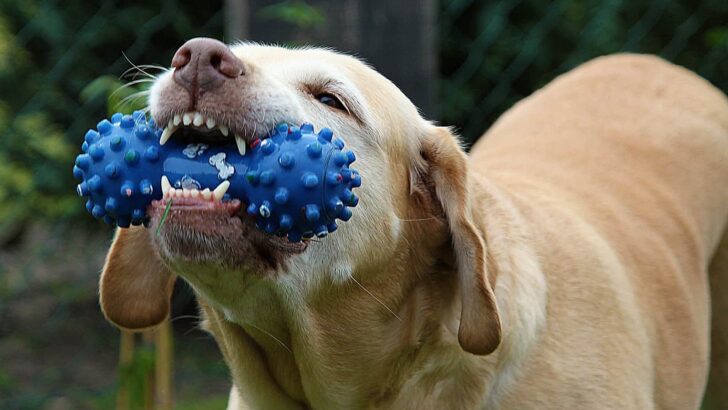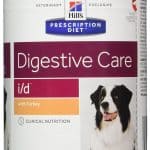- Nom Nom Dog Food Subscription Review - November 7, 2023
- 7 Best Dog Bed Ideas For Great Dane (DIY Options) - July 16, 2022
- Top 5 Rated Best Non-Prescription Diabetic Dog Food - July 15, 2022
Periodontal disease affects more than 80% of dogs above the age of 3
http://nypost.com/2014/09/13/vets-are-divided-over-a-new-way-to-clean-your-dogs-teeth/
. It is the direct result of poor dental hygiene for your favorite canine. Dogs can accumulate plaque and tartar under their gum line. When left uncleaned, this can lead to bacterial infections, which can destroy the bony structure that holds their teeth together. In addition to that, the bacteria can also enter their blood stream and affect other organs in the body like heart, kidney, and liver.
Visible tartar build-up on your dog’s teeth is a telltale sign that it needs oral cleaning. In the absence of visible tartar or plaque buildup, check for swollen gums that are more red than usual. Swollen gums signal gingivitis, which needs vet care. This brings me to the often asked question of, “Do I need to brush my dog’s teeth?”
Do you need to brush your dog’s teeth?
Given that an uncanny majority of dogs suffer from periodontal disease – most cases of which also go unnoticed till very late – it is safe to say that it is imperative that you brush your dog’s teeth. The better question to ask is, “How often?”
While vets recommend cleaning your canine’s teeth every day, it can be a time-consuming task. In most cases, 2-3 times a week should work fine. An even bigger question though is, how to do it? Dog teeth cleaning cost can be upward of $1,000. You don’t want to shell that kind of money every week; moreover, you don’t need to either.
Tips for brushing your dog’s teeth at home
First up, it is important that you take your dog to a vet for dental checkup at least once a year. A veterinarian will put your dog under anesthesia for a thorough dental checkup. He will conduct a complete exam, including x-rays, to determine any severe issues like loss of teeth, loss of bone density, and build up of plaque and tartar. If your dog has any of these issues, it is not a good idea to go poking around with a toothbrush. It will irritate him, which can lead to aggressive behavior.
It is a myth that an anesthetic procedure for animals is risky. It is about as risky as it is for humans. The common argument given against anesthetic procedures for animals is that they can have an adverse reaction. However, current vet standards are quite safe for your pets. Your vet will conduct a thorough examination of your pet before putting it under anesthesia. This includes blood tests and checking for conditions like skin allergies, cancers, or such ailments. Dogs that are prone to severe skin allergies like French bulldogs are generally more risky to be put under anesthesia. Other than that, geriatric dogs are also at risk of complications from anesthesia. For such dogs, restraints are the solution. Restraints can be a traumatic experience for your dog though, which is why visits to a professional should be limited to once or twice a year.
In any case, if your dog does not have a bad case of plaque or tartar buildup, home-cleaning should work fine.
1. Skip the toothbrush
If you are initiating your dog into oral hygiene, it is important that you don’t start with a toothbrush right off the bat. It is a patient process and you need to start with fingers. Find a suitable time when your dog is relaxed and close to you. Lift his upper lip and rub your index finger gently on his teeth. Use positive reinforcement to make the experience rewarding for him. This could include encouraging words, a treat after, or maybe even a jog in the park. At first, your dog will be irritable to the exercise. It is important that you do not scold him. Treat him as you would a 3 year old. Also, absolutely avoid doing this when your dog has just woken up from sleep or has just eaten.
2. Graduate to gauze
Once your dog is comfortable with the finger, pick up some gauze, dip it in warm water, and rub it on your dog’s teeth. Repeat it 2-3 times a day, until your dog is comfortable, before you apply some dog-friendly toothpaste. Toothpaste meant for humans should never be used to brush dog’s teeth. It has fluoride, which can have an adverse reaction in dogs. Dogs don’t know how to spit, which is why they ingest toothpaste. CET has several flavors in doggie toothpaste. Try a few and see which ones does your dog like.
Myth: Some people are averse to the idea of using doggie toothpaste for brushing their pet’s teeth. The rationale given is that it contains chemicals that can lead to neurological problems in animals. However, no scientific study has come forth to substantiate that claim. On the contrary, vets often recommend toothpaste specifically made for pets, since it helps break down bacteria and prevent build-up of plaque.
3. Time for toothbrush
If everything has been going great thus far, you should get started with a toothbrush. A kid’s toothbrush is fine to begin with. You could even get hold of a finger dog toothbrush in the beginning. Go slow. Brush teeth in batches. Brushing one side of the mouth at the start of the day and the other in the evening is a good idea. Like previously, make sure you associate the process with rewards. Get him a treat or take him out for a walk. As he gets comfortable with routine, buy a dog toothbrush that has soft bristles. A toothbrush specifically made for canines is able to reach more efficiently beyond the gum line and get rid of plaque.
How to brush a dog’s teeth
When brushing, you need to grab the dog’s jowls the right way. Get hold of the muzzle so he cannot chew on the brush. Lift one side of the lip gently and brush gently. Repeat the process on the other side.
For difficult dogs
Not every dog reacts genially to the process of brushing. Small breeds especially can be obstinate and won’t allow anything in their mouth other than a gauze. In such cases, pre-treated dental wipes are your best friend. The soft wipes are treated with baking-soda that can fight bacteria and prevent build-up of tartar and plaque in your pet’s mouth. However, if you are only using dental wipes for your dog’s oral hygiene, it is important that you take him to a vet every 6 months for professional cleaning.
What about dental treats?
Dental treats can help with a dog’s oral hygiene. However, it is important that you pick treats that are clinically proven to fight plaque and tartar. Dentastix is a good choice. The X-shaped treats reach beyond the gum line to clean accumulated bacteria and tartar. Whimzees is another alternative if you are looking for useful dog treats. Make sure you stay around your dog when you are using dog treats. There is a choking risk involved. Rawhide is another popular brand of chew sticks out there, which comes under a lot of unfounded flak often. Rawhide poses the same percentage of risks as any other dog treats in the market. The thing to remember is to never let the dog chew on any dental treats for more than 20 minutes at once. Most dental treats are made from raw hide, which can cause digestive irritation if consumed in large amounts. You should also check if your dog has allergic reactions to chew sticks. Diarrhea is a common symptom of allergic reactions and irritation.
Check out our comparison review between Dentastix and Greenies, two of the known product for your dog’s dental health.
Fresh food can help
A common argument given by people against brushing their dog’s teeth is that canines were never so coddled in the wild. There are two problems with that argument. One, there is no telling if dogs in the wild were free from dental problems. Two, they miss the fact that there is considerable difference in the diet of domesticated dogs and dogs in the wild. Domesticated dogs rely on commercially packed food. The cheap varieties mostly contain a lot of fluff that don’t add a lot of nutritional value to your dog’s diet. Fresh food can help fight dental problems in pets.
Include fresh meat in your dog’s diet, as it can help prevent buildup of tartar and plaque. Even fresh vegetables can be beneficial, since natural juices present in them prevent accumulation of bacteria in the mouth.
Give bones to chew
Bones can reduce the buildup of plaque, especially in dogs’ molars. Small breeds should not be given bones to chew though, since they are at a very high risk of choking. Use a size-appropriate bone for medium sized and large dog breeds. Avoid poultry bones, since they can be brittle and lead to choking. Stick to beef or pork bones. Make sure you boil the bone to soften it, which makes it easier for the dog to chew. Hard bones can fracture your dog’s teeth. Refrain from using barbecued or baked bones, since they can be too brittle for a dog’s strong jaw. Natural juices present in bones help wash away a lot of bacteria that may have accumulated in your dog’s mouth. You don’t need to do this activity every day though. 2-3 times a week for about 15 minutes after dinner should work fine.
The debatable new fad
Over the last couple of years, a lot of “services” have come up that claim to clean dogs’ teeth without the use of anesthesia. They wrap your canine in a towel, play some soothing music, and clean his teeth. The problem is, it is merely a cosmetic procedure than rigorous cleaning. That is not to say that such services are entirely refutable. However, they are not offering anything that cannot be done at home. They can also not replace professional cleaning done by a qualified dog dentist. Such services should only be used as a last resort, when every effort to clean your dog’s teeth has failed.
Tips on how to brush a dog’s teeth
- Schedule a time when you brush your dog’s teeth. In the beginning, once a week should be fine. Increase the number of days once your dog gets used to it.
- While brushing your dog’s teeth, make sure you never stand behind the dog or on top of the dog. Animals feels threatened that way. Sit beside him or kneel in front and gran the jowls gently.
- Apply a little bit of toothpaste on your finger and let the dog lick it before you proceed with the brush. Doing so lets him know that a reward is coming soon after.
- Place the brush at about a 45 degree angle and make small, circular motions on the teeth. If there is bleeding involved, you are either pressing too hard with the brush, or it can be a symptom of a periodontal disease. In the case of latter, you should schedule a vet appointment immediately.
- It is important that you get behind the teeth to the gum line where plaque and tartar hides. If you are unable to get there with the normal brush, use a finger brush. Chews can help too, although prolonged use is not recommended.
- Use pre-treated dental wipes every now and then for optimal oral hygiene.
- Don’t spend too much time brushing your dog’s teeth. One to two minutes should suffice. In the beginning, when your dog is averse to the idea, brush in batches for not more than 30 seconds.
- You should include dental rinses too in your dog’s oral hygiene. Dental rinses can be easily added to the water bowl. However, make sure you use ones that do not have Xylitol. The chemical is toxic for pets.
- Read up on oral anatomy for your breed. That way, you can spot any abnormalities quickly while brushing your dog’s teeth. It is not uncommon for dogs to develop lumps in their mouth, which should be checked by a vet.
When to see a dog dentist
Most times, you can take care of your dog’s dental hygiene at home. However, there are times when you need to schedule an appointment with a dentist. If your dog shows any of these symptoms, schedule a dentist visit ASAP.
- Swollen gums that appear too red or purple
- Bad breath for a prolonged period of time
- Bleeding gums
- Unexplained change in chewing habit
- Constant pawing at the mouth
- Depression
A DIY solution for examination
You can perform a preliminary test at home to check for dental diseases in dogs with the help of OraStrip. The strip works by extracting a saliva sample from your dog’s mouth. You simply need to place the pad end of the strip inside your dog’s mouth such that is touches the upper gum line. The entire process should take less than 10 seconds. The color of the strip indicates if your dog has any dental health issues. You can get the strips at your local vet store.
A DIY solution for dental care
If you are the skeptical kind who can never be sure about most brands out there, here is a quick DIY fix to help you out. You need the following ingredients:
- 3% hydrogen peroxide
- Aloe vera juice
- Baking soda
Mix 2 oz of hydrogen peroxide with 2 oz of aloe vera juice and 1 tablespoon of baking soda. You can keep the mixture in a bottle. Take some gauze, soak it in the mix, and apply to your dog’s teeth and gums. Pay special attention to the upper molars, as that’s where plaque gets accumulated most often. Hydrogen peroxide and aloe vera help prevent the build-up of plaque, while baking soda helps control the problem of bad breath. For small breeds, you can use a Q-tip instead.
Myths about dog dental hygiene busted
1. You should give only dry food
Dry food is abrasive, which helps to clean off tartar and plaque to some extent. Wet food on the other hand can get stuck between the teeth, leading to buildup of bacteria. However, feeding your dog only dry food will lead to deficiencies and health problems. It takes a mix of good diet and good oral hygiene practices for optimal dental health.
2. Bad breath in pets is common
While pets may not have breath as fresh smelling as humans, severe bad breath can be caused due to underlying dental problems such as gingivitis.
3. Dogs with dental issues do not eat
Animals have strong survival instincts. Despite discomfort in their mouth, they will continue to eat and might not even show signs of discomfort unless you look closely. Regular checkups at a dog dentist are therefore necessary. Subtle changes in the way your dog chews food should not be overlooked.
4. Fractured teeth need to be replaced
That’s not the case all the time. There are cases of uncomplicated fracture where the crown can be smoothened out and the tooth repaired. Your dog dentist is the best person to advise you in case of tooth fractures.
Continue reading:




